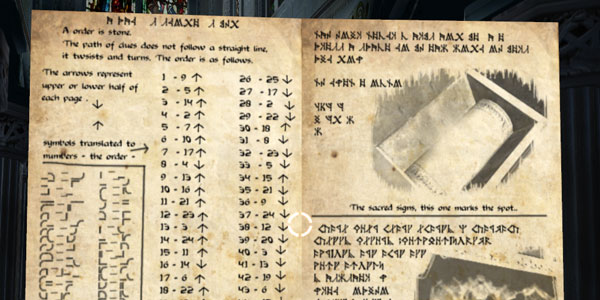The Da Vinci Mode: Rosslyn
The Hivemind have told you I’m helping out this week. The truth is I’ve been kidnapped by Quinns in a hot air balloon. I don’t want to write about the Personal Computer games. I am being forced. Send help. They make me play games with lots of religious imagery, which my enfeebled mind finds impossible to resist. Games like Rosslyn: The Templar Mystery, which is essentially a first-person point and click, with a very holy escape-the-room vibe. The whole game is set in Rosslyn Chapel – wot was in that Da Vinci Code – where you have to leaf through your grandfather’s old diary to find the clues to solve 51 puzzles hidden in the statues, stonework and tombs. I like it quite a little. But then I would say that. Quinns is pointing a rusty bayonet at me.
No, he isn’t. Read more of my genuinely held impressions after the jump.
It can be quite a slow-burning game too. You walk around with usual FPS aplomb but constantly have to refer to the diary for help. Before you even get onto the first few puzzles you have to figure out how to navigate the book, using the smattering of notes left by Grandaddy Black. You know you’re in it for the long haul when the first puzzle is a contents page.
After you’ve consulted the diary, it’s usually a matter of finding the right bit of brickwork and pushing, pulling or twisting it the right way. Occasionally you’ll get a medallion or a coin, which hop into your inventory menu for use somewhere later on.
The puzzles have a specific order and only the relevant bits and bobs around the chapel become active, so there’s no way you can solve multiple puzzles at once, or skip to a later one. Anyway that would be crazy because you’d need to be a high-functioning Tom Hanks to take in this many clues at once. In Rosslyn Chapel you begin to get that familiar sense of adventure game paranoia. Every tiny statuette, every stained-glass window, every beam of light and tiny pixellated symbol becomes meaningful. Which is a funny feeling and sometimes a frustrating one.
This explains the echoey musical soundtrack - a medieval hum which is probably designed to keep you calm. Or it’s just there to add a nice Roman Catholic atmosphere. Doesn’t matter. It does both. Even so, it isn’t something you could fire through on a single sitting. Thankfully, it notifies you and auto-saves after every solution. Perfect for popping in and out of for fifteen minutes on a dreary Sunday. Like mass.
It isn’t anywhere near as spooky as Amnesia. But it does develop a similarly uneasy feeling of being trapped in an unfamiliar place. It's a slower, more chin-scratchy kind of fear. Not a fear of monsters, just a fear of being stupid. A lot of the game's atmosphere is thanks to the book, with its scribbles and cryptic runic text. You always have to go back to reading. So proud are developers Ovine By Design that they've even made a PDF version of it available for download. "Ninety percent of archaeology is done in the library," as a famous archaeologist once said. "The other ten percent is on PC." That's true. Word for word, that's what he said.
Anyway. Go play and see already.



